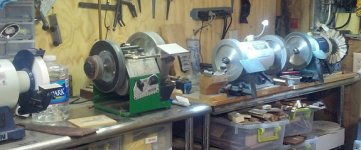that pile of metal dust around his sander...
A warning about the fire hazard of metal dust…
As a woodturner I sharpen lathe tools often. These days many woodturners use CBN wheels on slow-speed bench grinders which produce some very fine pure steel dust. (CBN wheels are similar to diamond wheels.)
(an outdated photo of my sharpening station)

Most of the steel dust collects on the workbench but the steel is fine enough to float through the air - I’ve found steel dust accumulating on magnets stored on the back of my bandsaw over 10’ from the grinders! (It’s important to wear a good respirator.)
Some, including me, position a strong magnet below the grinding wheel to collect much of the dust, typically placing the magnet in a small plastic bag to make the dust easier to get off the magnet. Sharpening with CBN produces only tiny sparks but they do occasionally throw a few, short, mostly quite “wimpy” sparks. (nothing like the sparks from a conventional grinding wheel, abrasive cuttoff wheels or an angle grinder - for general metalworking I do most of the “serious” grinding and welding outside.)
Once the magnet below a coarse 60 grit CBN wheel was overdue for cleaning and had accumulated a small fuzzy ball of extremely fine steel dust. If you’ve ever experimented with burning fine steel wool you know how flammable steel can be.
In my case, after an aggressive grinding session shaping some large tools I looked down and noticed the fuzzy ball of steel dust on the magnet was glowing orange in middle - one of the tiny sparks had ignited it! I quickly took it outside and found a tiny glowing nugget of molten steel in the middle! It might have quit burning by itself (and it was on a stainless steel workbench) and may not have burned the shop down but I learned my lesson - just like wood dust don’t let steel dust accumulate!
In discussing this on the woodturning forums no one else reported experiencing steel dust ignition. It might be rare in a hobby situation but it would only take once to ruin your year.
JKJ